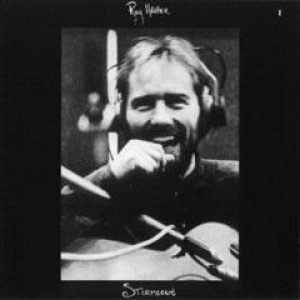When Stormcock arrived in 1971, it didn’t just follow Roy Harper’s previous work—it redefined it. As his fifth studio album, it stepped beyond the more concise songwriting of albums like Flat Baroque and Berserk and leaned fully into long-form storytelling. Harper used just four tracks to fill the record, but each song stretched far past the usual radio-ready runtime. The result was a bold and unhurried work that felt closer to a folk opera than a collection of singles.
The early 1970s were a time when artists were breaking out of traditional song forms, and Stormcock fit right into that experimental wave. While some of Harper’s peers in the folk scene stuck to simple arrangements, he blended acoustic guitar work with sweeping orchestration and poetic lyrics that challenged both the ear and the mind. It was clear this wasn’t a commercial bid—it was a personal mission.
Harper has often pointed to Stormcock as a platform for serious thought. Through its long verses and shifting musical moods, he took on big themes like war, power, and the search for truth. His goal seemed to be about more than entertainment; he wanted to provoke, to stir something deeper in the listener. By stripping away the constraints of traditional song structure, Harper gave himself space to explore those ideas with clarity and depth.
Sonic Exploration

From the opening chords of Stormcock, it’s clear this is not a casual listen. The production, handled with precision and restraint, avoids the over-polished gloss common in many early ’70s records. Instead, it embraces a clean, open sound that allows each element—voice, guitar, and orchestration—to breathe. There’s a clarity here that feels deliberate, almost austere. The mix puts Harper’s voice and guitar front and center, giving the impression of a solitary figure in a vast, echoing space. This minimalist approach enhances the album’s introspective tone, giving weight to every word and chord.
The arrangements are deceptively complex. Harper’s guitar work, often using unconventional tunings, serves as both rhythm and melody, weaving intricate fingerpicked patterns that pulse beneath the lyrics. He layers these textures with subtle shifts in dynamics, moving from delicate passages to forceful crescendos. One standout is the orchestral backdrop in “Me and My Woman,” arranged by David Bedford. It swells and recedes like a tide, complementing the song’s emotional arc without overwhelming it. Elsewhere, guest contributions are handled with care—Jimmy Page’s appearance under a pseudonym adds depth without stealing focus.
Genre-wise, Stormcock sits comfortably within progressive folk, but it doesn’t stay confined there. It draws on elements of classical composition, protest songwriting, and even touches of psychedelia. What sets it apart is how naturally these influences are integrated. Rather than genre-hopping for effect, Harper builds a cohesive sonic world where folk storytelling meets avant-garde ambition. The result is an album that feels timeless, refusing to settle into easy categories.
Lyrical Analysis

At its core, Stormcock is an album built on words—carefully chosen, passionately delivered, and loaded with meaning. Roy Harper uses his lyrics not just to tell stories, but to confront, question, and reflect. Across the album’s four sprawling tracks, he tackles themes like political hypocrisy, personal freedom, the failures of organized religion, and the search for genuine human connection. These aren’t casual musings—they’re pointed observations aimed at the structures that shape our lives.
In “The Same Old Rock,” Harper goes after blind faith and institutional control, using vivid metaphors to critique the way belief systems can become prisons. The lyrics are dense with symbolism, but never feel overstuffed. He invites the listener to peel back the layers, making each listen feel like a deeper dive. On “One Man Rock and Roll Band,” the focus turns inward. Harper reflects on his place in the world, the role of the artist, and the cost of speaking truth in a culture that often prefers silence. It’s both personal and universal—a diary entry with a public purpose.
His writing style leans heavily toward the poetic. Lines twist and turn, often resisting easy interpretation. But that complexity is part of the album’s charm. Harper doesn’t write to explain; he writes to explore. At times, his lyrics feel almost like sermons or soliloquies, delivered in a voice that’s both weary and defiant. There are no easy hooks or catchy refrains—just long-form lyrical journeys that reward patience and attention.
Emotional Impact
Emotionally, the album is intense and unfiltered. Harper’s delivery carries a raw sincerity that makes the most abstract lines feel grounded in real experience. Whether he’s railing against injustice or lamenting lost love, there’s a fire behind the words. The result is a record that not only challenges the mind but stirs the heart. It demands engagement, but offers deep emotional rewards in return.
Cohesion and Flow

Though Stormcock is composed of only four tracks, each stretching well past the standard song length, the album never feels disjointed. Instead, its structure unfolds like a carefully arranged suite, where each piece builds upon the last. The progression is both emotional and philosophical, guiding the listener through waves of critique, introspection, and subtle hope.
The opening track, “Hors d’Oeuvres,” sets the tone with its sharp commentary on media manipulation and societal complacency. It acts as a prelude—an intellectual doorway into the themes Harper will explore more deeply in the following songs. “The Same Old Rock” picks up that thread, widening the lens to challenge religious dogma and the conformity it breeds. As the longest track on the album, it stands at the center of the record, not just in length but in thematic weight.
By the time we reach “One Man Rock and Roll Band,” the mood shifts slightly inward. The external critique gives way to personal reflection, though the urgency remains. This transition is subtle and well-paced, offering a moment of self-examination before the sweeping finale. “Me and My Woman” closes the album with a blend of emotional vulnerability and grandeur. It doesn’t resolve the questions posed earlier, but it humanizes them, rooting the abstract in the tangible realm of love and loss.
Throughout Stormcock, Harper maintains a consistent tone and aesthetic. His voice, both literal and artistic, remains steady—even when the musical arrangements shift or the lyrical focus narrows. The blend of folk, classical, and experimental sounds serves as a unifying thread, as do the recurring themes of truth-seeking and resistance. There are no jarring jumps or stylistic detours. Instead, the album moves with purpose, each track flowing naturally into the next.
Standout Tracks and Moments
Although Stormcock is best experienced as a continuous listen, each of its four tracks offers its own distinct weight and brilliance. Still, a few moments rise above even in this tightly woven tapestry.
The Same Old Rock
“The Same Old Rock” is arguably the centerpiece of the album. It stands out not just for its length, but for the force of its message and the sophistication of its musical build. Harper’s fingerpicked guitar lays a restless, hypnotic foundation, while his lyrics take a direct aim at dogma and ideological submission. What makes the track so powerful is its balance of fire and finesse—anger rendered as poetry. Jimmy Page’s subtle, layered guitar work under a pseudonym adds a shadowy presence, elevating the track without distracting from Harper’s central voice.
Me and My Woman
“Me and My Woman” also deserves special attention. It closes the album with a dramatic flair that feels almost cinematic. David Bedford’s orchestral arrangement is a triumph here, guiding the track through dynamic shifts that mirror the emotional tides of the lyrics. There’s one particular moment—a swell of strings after Harper sings, “I’m the sunlight in your hair”—that feels like the entire record taking a deep breath. It’s tender, expansive, and unguarded.
One Man Rock and Roll Band
On “One Man Rock and Roll Band,” Harper turns the lens on himself. The standout here is his vocal delivery, which walks a tightrope between vulnerability and defiance. The way he stretches certain lines, allowing them to hang in silence before snapping back into rhythm, creates a sense of raw tension. It’s not just what he says, but how he says it that makes the song resonate.
Hors d’Oeuvres
Even the album’s opener, “Hors d’Oeuvres,” has its moment of quiet brilliance. A line like “And it’s all happening in the middle of my head” captures the introspective heart of the record. It signals to the listener that this journey will be as much inward as it is outward.
Artistic Contribution and Innovation

Stormcock holds a singular place within the folk and progressive rock landscapes of the early 1970s. At a time when many artists were chasing radio play and commercial formats, Roy Harper doubled down on artistic autonomy. He abandoned the three-minute song structure, sidestepped mainstream production formulas, and offered an album that was unapologetically dense, provocative, and demanding. In doing so, he not only set himself apart from many of his contemporaries, but also expanded the creative possibilities of what a singer-songwriter could achieve within the folk genre.
While artists like Nick Drake and John Martyn were also exploring more introspective and textured paths in folk music, Harper’s Stormcock pushed further into conceptual territory. His use of extended song forms, orchestral arrangements, and unflinching social commentary placed the album closer to the realm of progressive rock, yet it never lost its acoustic heart. In this way, Stormcock bridged the gap between genres without compromising its identity.
Innovation
One of the most innovative aspects of the album is its structure. With only four tracks, Harper created a sense of epic storytelling more commonly found in classical compositions or progressive suites. This choice alone defied industry expectations and proved that a folk record could aim for—and achieve—operatic scale. His integration of poetic lyrics with intricate guitar work and orchestral flourishes was equally bold. Rather than using strings as background ornamentation, Harper and arranger David Bedford crafted them as active participants in the musical conversation, shaping the emotional arc of the songs.
Thematically, Stormcock was also ahead of its time. Its critiques of power, religion, and mass media feel just as urgent today as they did over five decades ago. Harper didn’t merely reflect his era—he challenged it. In doing so, he created a body of work that remains relevant, not just as a snapshot of its time, but as an enduring call for critical thought and artistic integrity.
Closing Thoughts

Stormcock is not an album that meets the listener halfway. It demands attention, patience, and a willingness to follow Roy Harper into uncharted territory. But for those who engage with it fully, the rewards are profound. Its strength lies in its ambition—lyrically dense, musically daring, and thematically bold, it stands as one of the most intellectually and emotionally challenging records of its era.
The album’s weaknesses are few, and even those are more about accessibility than execution. Its length and complexity may alienate casual listeners or those looking for instant gratification. There’s no obvious single, no easy entry point. But that’s part of its integrity. Harper wasn’t trying to craft a hit; he was trying to make a statement, and he succeeded.
Within Harper’s body of work, Stormcock stands as a defining moment. It encapsulates his uncompromising artistic spirit and his refusal to dilute his vision. In the broader landscape of British folk and progressive music, it remains a high-water mark—a cult classic that continues to resonate with those who value lyrical depth and musical freedom.
Official Rating: 9/10
This rating reflects both the album’s artistic excellence and its lasting impact. It earns a near-perfect score for its fearless execution, its thematic resonance, and its boundary-pushing structure. The only reason it doesn’t reach a full ten is because its inaccessibility may limit its reach. Still, Stormcock is a masterwork—one that rewards every moment you give to it, and one that continues to speak loudly in a world that too often favors silence.
